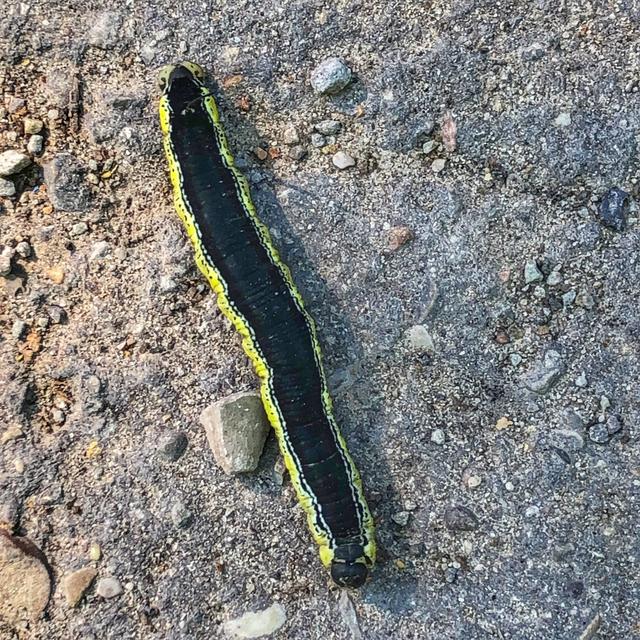Catalpa sphinx
Ceratomia catalpae (Boisduval, 1875)
Family: Sphingidae
Subfamily: Sphinginae
Identification: Forewing is yellowish brown with no white markings and indistinct black lines and dashes. Cell spot is gray with a black outline. Hindwing is yellowish brown with obscure lines.
Wing Span: 2 9/16 - 3 3/4 inches (6.5 - 9.5 cm).
Life History: Adult moths fly at night. Females lay large clusters of eggs on the underside of host leaves or smaller clusters on twigs and branches. Young caterpillars feed together in groups; older ones feed singly. Fully-grown caterpillars crawl down the tree trunk to pupate and overwinter in chambers dug 2-3 inches into the soil. Caterpillars are often parasitized by a wasp, Apanteles congregatus, which lays its eggs inside the caterpillar. The caterpillar eventually dies as the wasp larvae feed inside it.
Flight: . Two flights from May-September.
Caterpillar Hosts: Catalpa species in the Bignoniaceae family.
Adult Food: Adults probably do not feed.
Habitat: Deciduous woodlands and suburban plantings.
Range: Eastern states from Maine west to Iowa; south to Florida, the Gulf States, and Texas. Also Colorado and Nebraska. Comment: Caterpillars are used as fish bait in the Southeast.
Conservation: Not usually required.
NCGR: G5 - Demonstrably secure globally, though it may be quite rare in parts of its range, especially at the periphery.
Management Needs: During outbreaks, caterpillars can defoliate catalpa trees.
Comments: NULL
Get your BAMONA Gear!
Please donate!
We depend on donations to keep Butterflies and Moths of North America freely available. We want to express our gratitude to all who showed their support by making a contribution this year. You can donate to support this project at any time.
Advertise with us!
Do you have a product or service that you think would interest BAMONA users? If you would like to advertise on this website, contact us by email, or use the contact form and select the "Advertising" category.
Verified Sightings
Displaying 49 - 72 of 512 verified sightings

Observation date: Jun 26, 2020
Submitted by: CincyJeff
Region: Clermont County, Ohio, United States
Verified by: Ohio97
Verified date: Jan 10, 2021

Observation date: Aug 30, 2016
Submitted by: Blue Swallowtail
Region: Cass County, Nebraska, United States
Verified by: J_Martineau
Verified date: Dec 02, 2020

Observation date: Oct 04, 2020
Submitted by: TioCeBoji
Region: Buncombe County, North Carolina, United States
Verified by: rogerdowner
Verified date: Oct 04, 2020

Observation date: Sep 14, 2020
Submitted by: Shelbysc
Region: Brown County, Ohio, United States
Verified by: rogerdowner
Verified date: Sep 14, 2020

Observation date: Aug 20, 2020
Submitted by: Stephen G.
Region: Benton County, Arkansas, United States
Verified by: Stephen G.
Verified date: Sep 13, 2020

Observation date: Aug 27, 2020
Submitted by: Dave Webb
Region: Harford County, Maryland, United States
Verified by: rogerdowner
Verified date: Sep 11, 2020

Observation date: Aug 28, 2020
Submitted by: kbemrald
Region: New Castle County, Delaware, United States
Verified by: rogerdowner
Verified date: Sep 04, 2020

Observation date: Sep 02, 2020
Submitted by: Cyrus Li
Region: Montgomery County, Virginia, United States
Verified by: rogerdowner
Verified date: Sep 02, 2020

Observation date: Sep 01, 2020
Submitted by: Cyrus Li
Region: Montgomery County, Virginia, United States
Verified by: rogerdowner
Verified date: Sep 02, 2020

Observation date: Jul 12, 2020
Submitted by: blueracer
Region: Ashland County, Ohio, United States
Verified by: rogerdowner
Verified date: Aug 29, 2020

Observation date: Aug 27, 2020
Submitted by: Cyrus Li
Region: Montgomery County, Virginia, United States
Verified by: rogerdowner
Verified date: Aug 28, 2020

Observation date: Aug 20, 2020
Submitted by: hackberry
Region: Allegheny County, Pennsylvania, United States
Verified by: curtis.lehman
Verified date: Aug 21, 2020

Observation date: Aug 14, 2020
Submitted by: Cyrus Li
Region: Montgomery County, Virginia, United States
Verified by: rogerdowner
Verified date: Aug 14, 2020

Observation date: Aug 08, 2020
Submitted by: reupurtbones
Region: Franklin County, Kentucky, United States
Verified by: rogerdowner
Verified date: Aug 09, 2020

Observation date: Aug 09, 2020
Submitted by: Cyrus Li
Region: Radford, Virginia, United States
Verified by: rogerdowner
Verified date: Aug 09, 2020

Observation date: Aug 04, 2020
Submitted by: nch5013
Region: Fayette County, West Virginia, United States
Verified by: curtis.lehman
Verified date: Aug 04, 2020

Observation date: Aug 01, 2020
Submitted by: Cyrus Li
Region: Montgomery County, Virginia, United States
Verified by: rogerdowner
Verified date: Aug 03, 2020

Observation date: Jul 23, 2020
Submitted by: Cyrus Li
Region: Montgomery County, Virginia, United States
Verified by: rogerdowner
Verified date: Jul 25, 2020

Observation date: Jul 06, 2020
Submitted by: agdsquash
Region: Cumberland County, Pennsylvania, United States
Verified by: curtis.lehman
Verified date: Jul 20, 2020

Observation date: Jul 19, 2020
Submitted by: Cyrus Li
Region: Floyd County, Virginia, United States
Verified by: rogerdowner
Verified date: Jul 19, 2020

Observation date: Jul 15, 2020
Submitted by: Rita Carroll
Region: Madison County, Virginia, United States
Verified by: rogerdowner
Verified date: Jul 15, 2020

Observation date: Jul 08, 2020
Submitted by: tmlehman
Region: Adams County, Indiana, United States
Verified by: rogerdowner
Verified date: Jul 09, 2020

Observation date: Aug 29, 2019
Submitted by: nightjarring
Region: Dickinson County, Kansas, United States
Verified by: stomlins701
Verified date: Jul 06, 2020

Observation date: Jul 01, 2020
Submitted by: Cyrus Li
Region: Montgomery County, Virginia, United States
Verified by: rogerdowner
Verified date: Jul 02, 2020
- ‹ previous
- 3 of 22
- next ›






